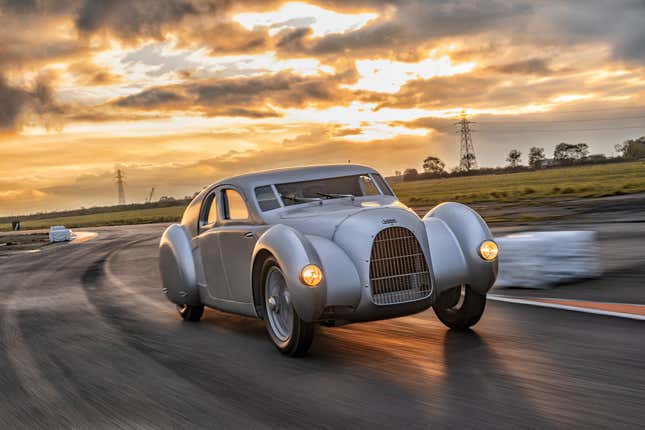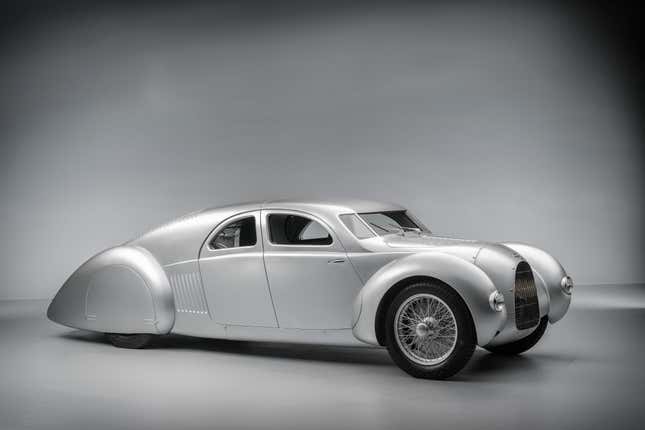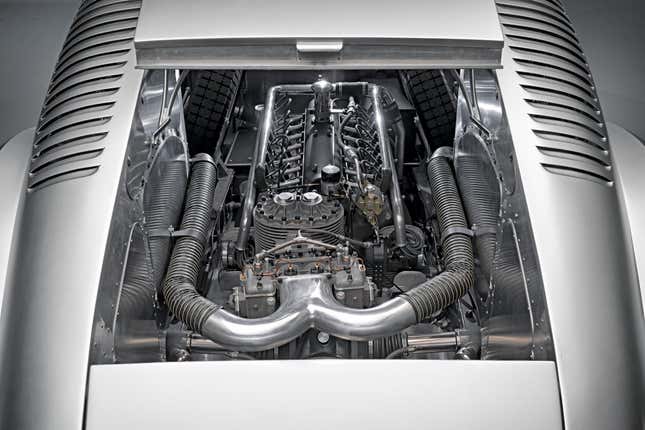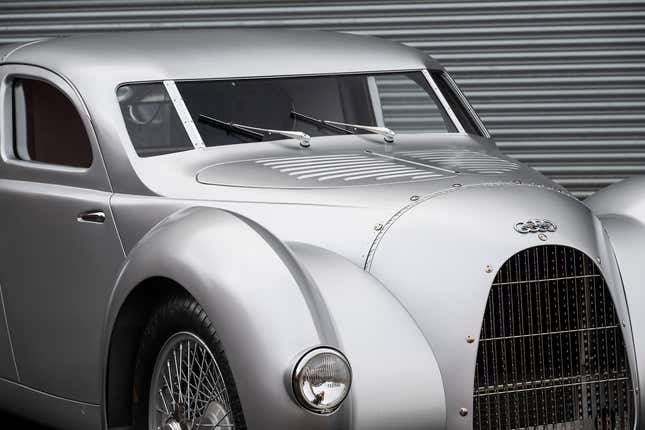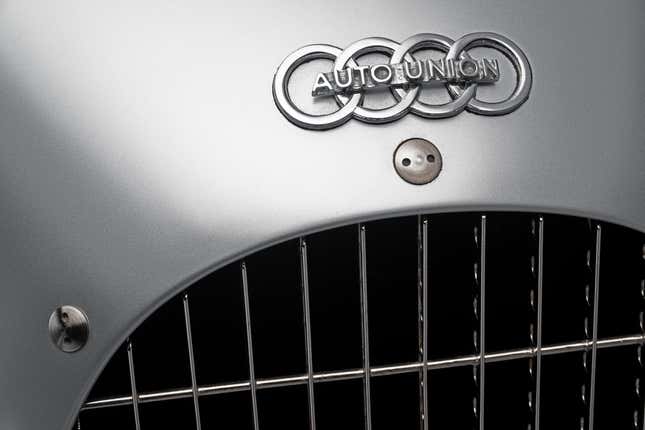Over the decades there have been many one-off or limited-production vehicles that have been lost to the sands of time, and many cars that were planned for production but never made it there, for various reasons. Some automakers have begun to build recreations or “continuation cars” to fill in the gaps of history, and Audi is the latest to jump in the ring — and with the most spectacular car of all. This is the Auto Union Type 52, a 16-cylinder supercar that was planned for production but never actually built, now fully realized by the Audi Tradition team and making its real-life debut at the Goodwood Festival of Speed.
The story starts in 1932, when Audi, DKW, Horch and Wanderer merged to form Auto Union AG. In the same year, new rules for Grand Prix racing were announced, to be implemented in 1934, and Auto Union got to work on world-beating race cars. While Mercedes-Benz’s race cars were front-engine, the Auto Union cars were the first to use a mid-engine layout, and the “Silver Arrow” cars from both brands absolutely dominated.

The first Auto Union racer was the 1934 Type A, which was designed by Ferdinand Porsche and had a giant supercharged V16 engine, a setup that was used by the subsequent 1935 Type B and 1936-1937 Type C, though the Type D of 1938 and 1939 used a supercharged V12. Despite these monstrous racers being unwieldy and hard to control, Auto Union set records and won lots of races, including the European championship in 1936.
What most of the world didn’t know about until now is that Auto Union also commissioned Porsche to create a supercar based on the Grand Prix cars. It was called the Schnellsportwagen — basically “fast sports car” — and it would have used a detuned V16 nabbed from the Grand Prix cars mounted in the middle of a ladder frame. Auto Union intended for the Type 52 to be bought by customers who would enter it in cross-country rallies like the Mille Miglia or endurance races like Le Mans, and the company considered making a factory race car out of it, too. With 197 horsepower and 322 pound-feet of torque from the 4.4-liter supercharged engine, it would’ve had a top speed of around 124 mph, making it one of the fastest road-legal cars of its day.
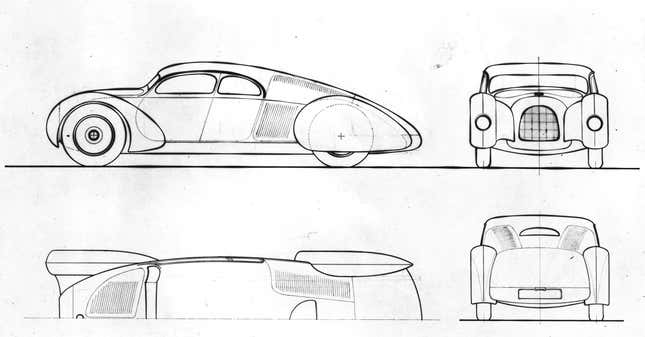
Porsche’s first sketches of Type 52 came at the end of 1933, and the following year the project managers were set to build a test car, but it seems like that never happened. In 1935 the project was abandoned, with the only evidence of its existence being documents and sketches that were buried in the Audi and Porsche archives. Audi’s Tradition division unearthed the Type 52’s plans a few years ago, commissioning British historic race manufacturer Crosthwaite & Gardner to bring the car to life, completing the Schnellsportwagen last year.
No photos of the car exist and there are no verified reports from people who worked on the project, so the teams had to rely on the original plans and engineering goals and go from there, which led to a number of technical changes needing to be made. The wheelbase had to be lengthened from 118 inches to 130.5 inches to fit the powertrain and suspension, and the 29-gallon fuel tank was relocated to underneath the seats, whereas the race cars have a larger tank mounted behind the driver. Every single component was custom-made and hand-crafted just for this car, and the result is spectacular.
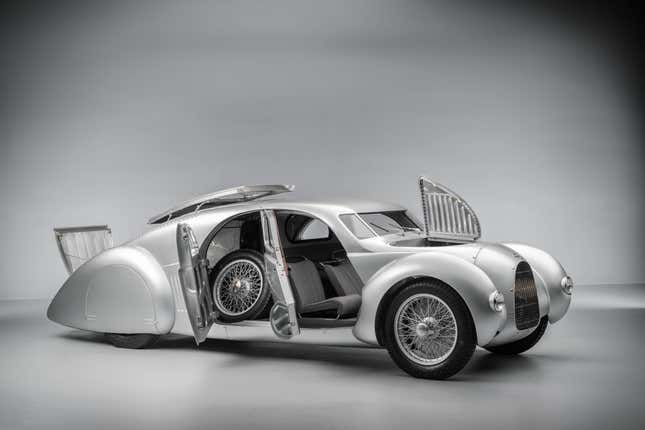
The Type 52 looks like nothing else in the automotive world, and at over 5 meters long it’s quite huge. Its prominent front fenders, small headlights and large grille obviously tie it in with the Auto Union racers, but once you get to the windshield the similarities end. Its super elongated teardrop shape, covered rear fenders and sleek rear deck are stunning, and there are tons of interesting details like the three-pane windshield, recessed oval rear window and bodywork rivets and latches. The plans said nothing about what color would be used, so Audi Tradition chose Cellulose Silver to match the race cars.
All four doors are rear-hinged, but the two rear doors open to a storage area that holds spare wheels. The Type 52 has a three-seat cabin with the driver sitting in the center and the passengers offset next to them, like in a McLaren F1, and Audi Tradition chose colors and fabrics inspired by the Grand Prix cars. There’s a ton of wood trim, beautiful large gauges and lots of intricate metal work, including the floor-mounted shifter for the 5-speed manual transmission. A large panel on the back of the car pops up and forward to show off the engine, paired with a rear-hinged panel further back that opens for luggage space, and it also has a pair of side-hinged panels on the hood to access mechanicals.

Unlike the original plans, which saw the Type 52 using a 4.4-liter V16 from the Type A, Audi Tradition decided to fit the Type 52 with a full-fat V16 from an Auto Union Type C race car, without any restrictions on output. To make sure it’s compatible with other existing Grand Prix cars, the supercharged 6.0-liter engine uses a fuel mix of 50 percent methanol, 40 percent unleaded and 10 percent toluene. The Type 52 makes 513 horsepower, the same as the race car, but Audi sadly doesn’t make any top speed claims. At 3,197 pounds unladen, the finished Type 52 is about 330 pounds heavier than the original plans said, and it uses drum brakes at all four wheels. While the Type 22 race car had transverse leaf springs and friction dampers, the Type 52 has longitudinal torsion springs with hydraulic dampers.
The Type 52 made its official debut at the Goodwood Festival of Speed this week, where it will not only be on display but get driven up the hill. Hans-Joachim Stuck, whose father was a 1930’s hill climb champion in Auto Union cars, had this to say about the Type 52 after a test drive: “The Schnellsportwagen is simply breathtaking: Its sound is incredibly sonorous – like it came from an orchestra. And the design of the Auto Union Type 52 will practically blow you away – it’s genius!”
